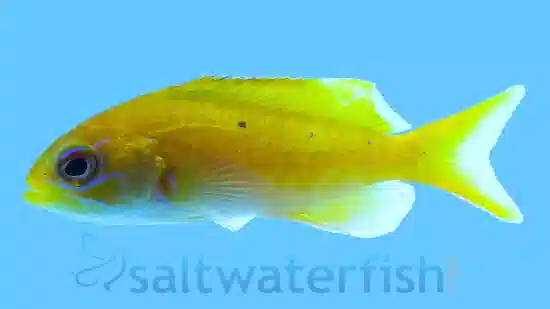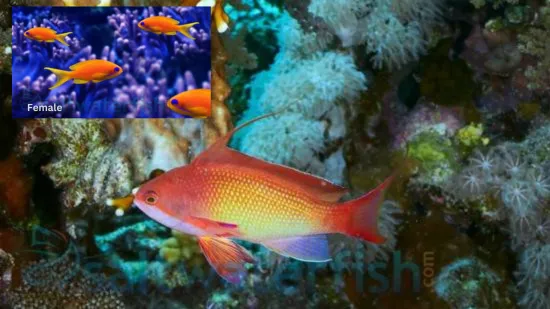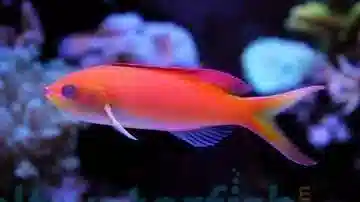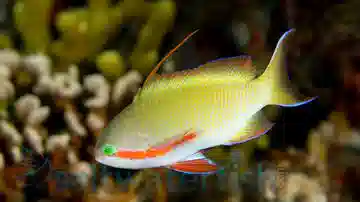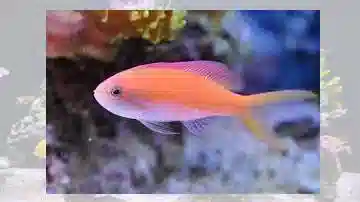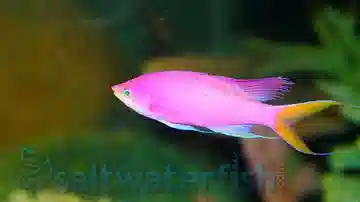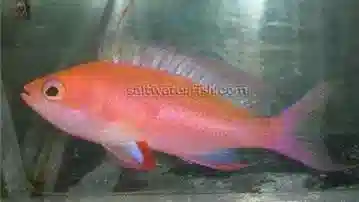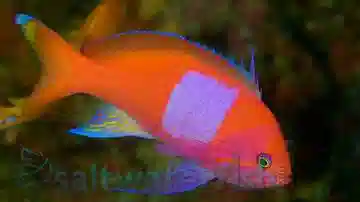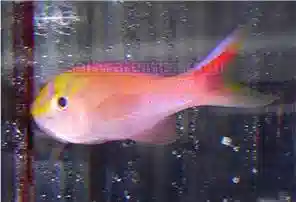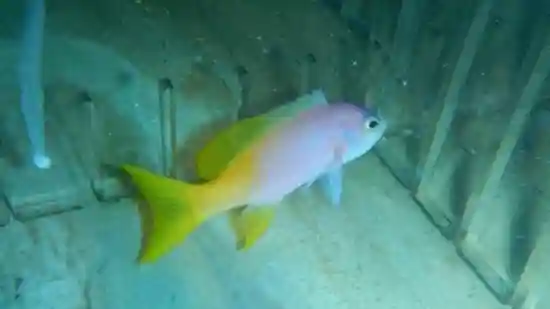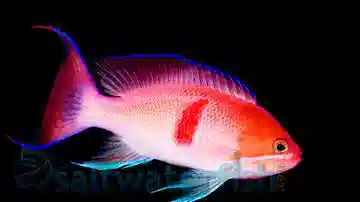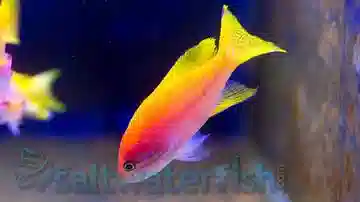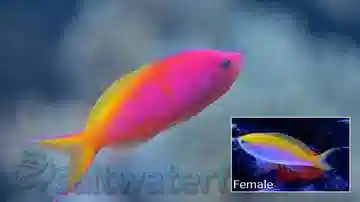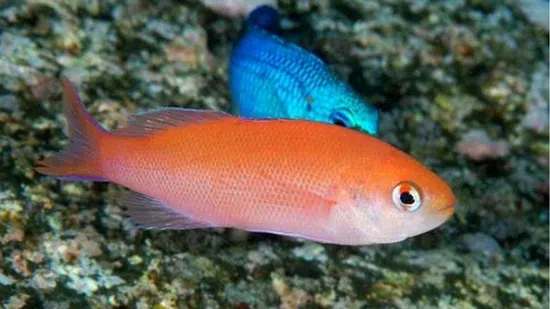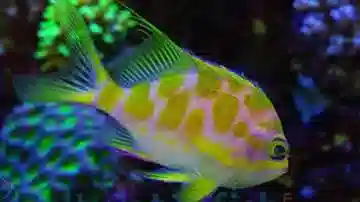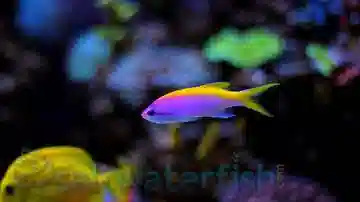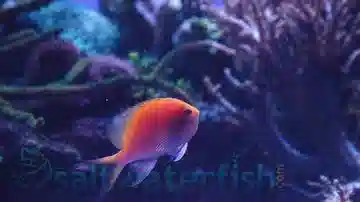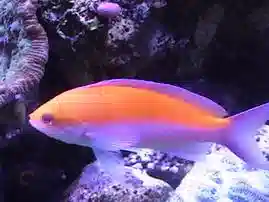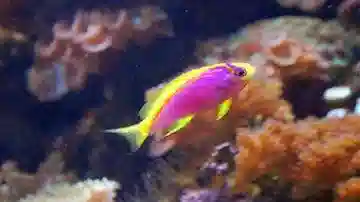Anthias In Saltwater Aquariums: FAQ
Yes, anthias are schooling fish by nature, and they thrive best when kept in groups. In the wild, anthias form large shoals hovering above reefs, where social structure plays a critical role in their health and behavior. In a home aquarium, keeping them in groups allows them to display their natural activity, vibrant colors, and dynamic interactions.
Ideal anthias group sizes:
Minimum group: 1 male with 3–5 females (a harem structure).
Larger tanks (125+ gallons): Groups of 7–10 or more can be kept successfully.
Small tanks (75–100 gallons): Start with a trio (1 male, 2 females).
Anthias are protogynous hermaphrodites, meaning all start as females, and the dominant one will transition into a male. If kept singly, anthias may survive, but they often hide, lose color, or show reduced activity compared to those in groups.
Scientific research confirms this: L Fishelson (1970) demonstrated that sex reversal and social dominance in anthias are tightly regulated by group dynamics, with removal of the male triggering a female to transition. These findings underline why keeping anthias in groups is not just aesthetic, it’s biologically necessary for long-term health and behavior.
Saltwaterfish.com customers often note success with groups. One Dispar Anthias reviewer wrote: “Bought 5 of these for my 125 gallon display tank \[...\] and now in the am all the anthias are in one corner all together. Healthy livestock and eating from day 1.” — Saltwaterfish.com Customer Review.
Pro tips for keeping anthias groups:
Provide ample swimming space and strong water flow, as they are active mid-water swimmers.
Feed small meals 2–3 times daily, anthias have high metabolisms.
Avoid housing multiple males in small tanks to reduce aggression.
Bottom line: Anthias should be kept in groups for their health, color, and natural behavior. A harem structure, one male with several females, works best in home aquariums. Provide the right space and diet, and you’ll enjoy one of the most striking displays in reef keeping, protected by Saltwaterfish.com’s 8-Day Live Guarantee.
Anthias are prized in reef aquariums for their brilliant colors and constant mid-water activity. With dozens of species available, some stand out as especially vibrant and popular for hobbyists looking to add a splash of movement and color.
Most colorful anthias for home aquariums:
Lyretail Anthias (Pseudanthias squamipinnis) – One of the most popular anthias, males display fiery orange to red bodies with flowing lyre-shaped tails, while females glow in vivid orange. Hardy and widely available.
Bartlett’s Anthias (Pseudanthias bartlettorum) – Striking purple-pink body with a bright yellow back, creating a neon two-tone effect. Perfect for smaller groups.
Dispar Anthias (Pseudanthias dispar) – Metallic orange to pink, with males showing stronger red hues. Peaceful and suitable for groups.
Squareback Anthias (Pseudanthias pleurotaenia) – Males feature a vivid purple-pink body with a bold magenta square patch. Stunning centerpiece fish for larger tanks.
Sunburst Anthias (Serranocirrhitus latus) – Smaller and shy but extremely colorful, with golden-orange bodies and hints of violet. Ideal for reef tanks with lots of rockwork.
Customer reviews reflect the appeal of their colors. One Saltwaterfish.com Dispar Anthias reviewer shared: “Great price, colorful.” — Saltwaterfish.com Customer Review.
Pro tips for keeping colorful anthias:
Use full-spectrum reef lighting to enhance natural fluorescence.
Keep them in groups (1 male, several females) for the best displays.
Provide frequent feedings to maintain their vibrant colors.
Bottom line: The most colorful anthias for aquariums include Lyretail, Bartlett’s, Dispar, Squareback, and Sunburst species. Each brings unique patterns and activity to your reef. Choose your favorites today from Saltwaterfish.com, backed by our 8-Day Live Guarantee.
Yes, while anthias are among the most stunning reef fish, not all species are equally easy to care for. Many require frequent feeding, strong flow, and large groups to thrive, which can overwhelm new aquarists. Fortunately, a few anthias species are known for being hardier, more adaptable, and beginner-friendly, making them excellent first choices.
Best hardy anthias for beginners:
Lyretail Anthias (Pseudanthias squamipinnis) – The most popular beginner anthias. Hardy, active, and brightly colored. Females are vivid orange, while males display striking red and purple hues. Best kept in harems of 1 male with several females.
Dispar Anthias (Pseudanthias dispar) – Peaceful, easygoing, and less aggressive than some anthias. Their smaller size (3–4 inches) makes them manageable in mid-sized reef tanks.
Bartlett’s Anthias (Pseudanthias bartlettorum) – Hardy and bold, with neon yellow and magenta coloration. They adapt quickly to prepared foods, making feeding easier for beginners.
These species stand out because they:
Adapt well to aquarium foods (mysis, brine, pellets).
Handle water quality fluctuations better than delicate species like Sunburst or Squareback Anthias.
Thrive in smaller groups compared to more specialized anthias.
These species adapt better to aquarium diets, tolerate moderate fluctuations in water quality, and thrive in smaller harems than more delicate anthias such as Sunbursts or Squarebacks. Field studies confirm that social structure and diet flexibility are key to anthias success, with Anthias squamipinnis (Lyretail) being one of the most widely distributed and resilient species (Fishelson, 1970).
Customer reviews confirm this. One Saltwaterfish.com Lyretail Anthias buyer shared: “Beautiful friendly fish. I purchased the male one and it arrived healthy and readily accepts frozen & flake food. Saltwaterfish.com did an awesome job of packing and sending healthy fish in my recent order.” — Saltwaterfish.com Customer Review.
Pro tips for beginner anthias care:
Keep them in groups (1 male, 3–5 females) for natural behavior.
Provide strong water flow and plenty of swimming space.
- Feed small amounts 2–3 times daily, they have high metabolisms.
Bottom line: The hardiest anthias for beginners are Lyretail, Dispar, and Bartlett’s. They’re colorful, active, and forgiving compared to more delicate species, perfect for new reef keepers. Shop your first anthias group today at Saltwaterfish.com, backed by our trusted 8-Day Live Guarantee.
Yes, anthias are considered reef safe and are a popular choice for mixed reef aquariums. In the wild, anthias such as the Lyretail (Pseudanthias squamipinnis) feed almost exclusively on plankton drifting in the current rather than corals, clams, or other invertebrates. This makes them excellent companions for SPS, LPS, and soft corals, as well as most reef invertebrates.
Why anthias are reef safe:
Diet: Anthias are mid-water planktivores. In aquaria, they readily accept frozen mysis, enriched brine shrimp, and quality pellets.
Behavior: They spend their time schooling in open water above rocks and corals, rarely making contact with benthic organisms.
Compatibility: Peaceful by nature, anthias generally coexist well with other reef-safe fish like clownfish, tangs, gobies, and wrasses.
That said, anthias have specific care requirements. They need frequent feeding (2–3 times daily) to match their high metabolism, and they thrive best in groups (one male with several females). They should be housed in aquariums of 75 gallons or more, with strong water flow and stable reef parameters.
Scientific studies confirm this plankton-feeding behavior. Hobson, author of Trophic relationships of fishes specialized to feed on zooplankters above coral reefs, documented that anthias and other planktivorous reef fishes feed primarily in the water column on zooplankton above coral reefs, making them unlikely to harm corals or sessile invertebrates.
Pro tips for success in reef tanks:
Feed small, frequent meals of frozen and pelletized plankton substitutes.
Keep them in groups for natural schooling behavior.
Ensure strong water flow to mimic their natural reef environment.
Bottom line: Anthias fish are 100% reef safe. Their plankton-based diet and mid-water swimming behavior make them ideal additions to coral reef aquariums. With proper feeding and care, they’ll add vibrant color and constant motion, backed by Saltwaterfish.com’s 8-Day Live Guarantee.
Anthias are among the most active reef fish, constantly swimming in the mid-water column. To fuel that activity, they need a nutrient-rich, varied diet, and because of their high metabolism, they require more frequent feedings than most saltwater fish.
Best foods for anthias in aquariums:
Frozen foods: Mysis shrimp, enriched brine shrimp, and finely chopped seafood (squid, clam, krill).
Prepared diets: High-quality marine pellets and flakes designed for carnivores and omnivores.
Plankton substitutes: Products like cyclopeeze or powdered reef foods replicate their natural zooplankton diet.
Occasional live foods: Copepods or baby brine shrimp can entice picky eaters, especially newly introduced anthias.
Because anthias are zooplanktivores in the wild, they naturally feed throughout the daylight hours. In aquariums, aim for at least 2–3 small meals per day instead of a single large feeding. Many aquarists use automatic feeders to maintain consistency.
One Dispar Anthias reviewer wrote: “Bought 5 of these for my 125 gallon display tank \[...\] and now in the am all the anthias are in one corner all together. Healthy livestock and eating from day 1.” — Saltwaterfish.com Customer Review.
Pro feeding tips:
Rotate between frozen and pellet foods to cover all nutritional needs.
Target-feed shy or less dominant anthias to ensure they eat.
- Supplement with vitamin-enriched foods to boost immune health.
Bottom line: In a home aquarium, anthias thrive on a varied, plankton-inspired diet of frozen, prepared, and supplemental foods. Feed them small portions multiple times daily, and they’ll reward you with nonstop activity and color, backed by Saltwaterfish.com’s 8-Day Live Guarantee.
Anthias are active, schooling fish that add constant movement and color to reef aquariums. But like all saltwater species, they are sensitive to water quality, tank dynamics, and feeding schedules. Recognizing the early signs of stress in anthias can help you correct issues before they lead to illness or loss.
Common signs of stress in anthias:
Hiding or isolation: Healthy anthias swim in the open water column. A stressed fish may retreat to rock crevices or corners.
Loss of color: Vibrant oranges, purples, and yellows may fade to pale shades when anthias are stressed.
Rapid breathing or gill movement: Often linked to poor water quality, low oxygen, or high ammonia/nitrite levels.
Refusal to eat: Anthias normally eat eagerly multiple times a day. Skipping meals is a red flag.
Erratic swimming: Darting, hovering near the surface, or staying in unusual positions may indicate aggression, bullying, or parameter swings.
Weight loss or pinched belly: Can signal underfeeding or food competition in group settings.
Scientific work on reef fish stress responses confirms these patterns. For example, Barton (Stress in fishes: a diversity of responses with particular reference to changes in circulating corticosteroids, 2002\) showed that stress in fishes elevates cortisol levels and leads to suppressed feeding, abnormal behavior, and color changes, all issues aquarists can observe in anthias under suboptimal conditions.
One Saltwaterfish.com Carberry Anthias reviewer wrote: “An awesome little beautiful Carberry Anthias \- South Asia who peacefully explores my large reef tank's caves. Almost always visible and active.” — Saltwaterfish.com Customer Review.
Pro tips to reduce anthias stress:
Keep them in groups (1 male with several females) for natural social behavior.
Provide frequent, small meals to meet their high metabolism.
Maintain stable reef water parameters (salinity 1.024–1.026, nitrates \<10 ppm).
Avoid housing multiple males in smaller tanks to prevent aggression.
Bottom line: Signs of stress in anthias include hiding, faded color, rapid breathing, loss of appetite, and erratic swimming. By maintaining stable conditions, frequent feeding, and proper group dynamics, you’ll keep your anthias vibrant and healthy, protected by Saltwaterfish.com’s 8-Day Live Guarantee.
Anthias are some of the most beautiful and active reef fish, but they also have one of the highest metabolisms in the hobby. In the wild, species like the Lyretail Anthias and Bartlett’s Anthias feed continuously on drifting plankton throughout the day. To keep them healthy in a home aquarium, their diet and feeding schedule need to reflect that natural rhythm.
Recommended feeding frequency for anthias:
2–3 small meals per day is ideal for most anthias.
In larger, established reef tanks with strong microfauna populations, you may get by with twice daily feedings, but three is better for growth and color.
Juvenile anthias often do best with 3–4 smaller meals while they’re developing.
Feeding only once per day almost always results in weight loss, color fading, and stress, since anthias simply cannot store enough energy to sustain their active lifestyle. Hobson, author of Trophic relationships of fishes specialized to feed on zooplankters above coral reefs. The Ecology of Fishes on Coral Reefs, documented that anthias forage continuously above reefs throughout daylight hours, underscoring the importance of frequent, small meals in aquaria.
One Sunset Anthius reviewer shared: “Very nice reef fish. Sunset Anthias \- South Asia cleans detritus in the live rock. Doesn't intrude on the reef. Easy keeper.” — Saltwaterfish.com Customer Review. Keeping anthias active and well-fed is a big part of that success.
Pro tips for feeding anthias:
Rotate between frozen mysis, enriched brine, pellets, and plankton substitutes.
Use an automatic feeder to provide midday meals if you’re away.
Target-feed less dominant anthias so they aren’t outcompeted.
- Add supplements like vitamin-enriched foods to boost immune health.
Bottom line: Feed anthias 2–3 times daily in small portions to match their natural plankton-feeding habits. Consistent, frequent meals will keep them colorful, energetic, and thriving, backed by Saltwaterfish.com’s 8-Day Live Guarantee.
Anthias are some of the most stunning schooling fish in the saltwater hobby, but they’re also active swimmers with high social and dietary needs. Tank size is critical, not just for swimming space, but for maintaining stable water quality and supporting their frequent feeding schedule.
General tank size guidelines for anthias:
Lyretail Anthias (Pseudanthias squamipinnis) – Minimum 75 gallons for a small group (1 male, 3–5 females). Larger tanks (100+ gallons) are better for long-term success.
Bartlett’s Anthias (Pseudanthias bartlettorum) – Can be kept in 70+ gallon tanks, making them slightly more flexible for mid-sized reefs.
Dispar Anthias (Pseudanthias dispar) – Peaceful and smaller; a trio can do well in a 65+ gallon aquarium.
Squareback Anthias (Pseudanthias pleurotaenia) – Large, showy species that need 125+ gallons due to size and activity level.
Sunburst Anthias (Serranocirrhitus latus) – Shyer and smaller, often housed singly or in pairs in 55–65 gallon tanks with lots of rockwork.
Anthias are mid-water swimmers that thrive in harems (1 male with several females). If kept in tanks that are too small, they may become stressed, lose color, or show aggression.
Anthias thrive in harems (one male with several females). In undersized tanks, they often become stressed, aggressive, or lose their vivid coloration. Research on anthias’ social structure shows that space and group size directly influence dominance and stress levels (L Fishelson (1970).
One Saltwaterfish.com Evansi Anthias reviewer wrote: “The Evansi Anthias \- Africa was shipped extremely well, and it was a perfect addition to my reef tank. I acclimated according to the instructions, and I have had no problems with any of the fish I have received. What more can you ask for? Cheaper then my local fish store and it was delivered to my front door the next day.” — Saltwaterfish.com Customer Review.
Pro tips:
Always plan for the adult size, most anthias reach 3–5 inches, with some like Squarebacks growing larger.
Provide open swimming space plus caves/rockwork for resting.
Keep lids secure, anthias are strong jumpers when startled.
Bottom line: The minimum tank size for anthias ranges from 55 to 125+ gallons, depending on species. Lyretails and Bartlett’s need at least 70–75 gallons, while Squarebacks demand much larger systems. Providing the right space ensures their schooling behavior, vivid color, and long-term health, backed by Saltwaterfish.com’s 8-Day Live Guarantee.
Anthias are tropical reef fish, naturally found in warm waters throughout the Indo-Pacific. To thrive in a home aquarium, they require a stable, reef-safe temperature range that mirrors their natural environment. Sudden fluctuations can quickly stress these active, mid-water swimmers, leading to weakened immune systems or even disease outbreaks.
Ideal water temperature range for anthias:
76–78°F (24–26°C) is the sweet spot for most anthias species.
They can tolerate 75–80°F in the short term, but consistency is critical.
Avoid swings greater than 1–2°F within a day, as this stresses their high metabolism.
This temperature range not only supports anthias’ constant mid-water swimming and frequent feeding needs, but it also matches the comfort zone for corals, shrimp, and most reef invertebrates.
Research on reef fish physiology shows that tropical planktivores like anthias reduce feeding and display higher stress when exposed to temperatures outside their natural range. In experimental trials, Munday et al. (2009) found that reef fish growth and survival declined sharply when temperatures exceeded their optimal tropical window, reinforcing the need for stable mid-to-upper 70s in captivity.
One Dispar Anthias Saltwaterfish.com reviewer wrote: “One of my favorite fish\! So much personality and the peach coloring is always an eye catcher\! This fish has become best friends with one of my shrimp and it lets the shrimp clean it\! Very happy with my purchase” — Saltwaterfish.com Customer Review.
Pro tips for maintaining temperature:
Use a reliable heater with a digital controller for accuracy.
Place heaters in sump compartments when possible for even heat distribution.
Use cooling fans or a chiller if your tank runs hot in summer.
- Always acclimate new anthias slowly to avoid temperature shock.
Bottom line: The ideal water temperature for anthias is a stable 76–78°F, with little daily fluctuation. Keeping them in this range supports strong coloration, natural schooling behavior, and long-term health, backed by Saltwaterfish.com’s 8-Day Live Guarantee.
Anthias are active, social reef fish that adapt well once established, but they’re also sensitive to shipping stress and water parameter changes. A careful acclimation process is critical for ensuring they adjust smoothly to your reef tank and begin eating right away.
Step-by-step drip acclimation for anthias:
1. Float the bag: Place the sealed shipping bag in your aquarium for 15–20 minutes to equalize temperature.
2. Transfer to a bucket: Gently pour the fish and shipping water into a clean container.
3. Set up a drip line: Using airline tubing, siphon tank water into the bucket at 2–4 drops per second.
4. Acclimate slowly: Allow this to run for 45–60 minutes, doubling the water volume in the bucket.
5. Net and release: Gently net the anthias and transfer them into your tank, never add shipping water to your display.
6. Lights off: Dim or turn off lights for a few hours to reduce stress during introduction.
Scientific studies on fish stress responses confirm why this matters. Rapid shifts in salinity or temperature trigger spikes in cortisol and immune suppression, while gradual acclimation reduces these effects and improves survival (Barton (Stress in fishes: a diversity of responses with particular reference to changes in circulating corticosteroids, 2002\).
One Saltwaterfish.com Red Belted Anthias reviewer shared: “All survived after 2 1/2 hr slow drip acclimation. He is a colorful little guy to watch darting around the tank. He is constantly on the move searching for food or detritus on the bottom as well as on reef rock.” — Saltwaterfish.com Customer Review. Proper acclimation plays a key role in that kind of success.
Pro tips for acclimating anthias:
Acclimate groups together to maintain social structure and reduce stress.
Keep tank lids secure, anthias may jump when startled.
Avoid aggressive tankmates during the first few days.
Offer small feedings of mysis or brine shrimp within the first 24 hours.
Bottom line: Acclimating anthias requires patience and stability. Use the drip method, keep conditions calm, and introduce them in groups for best results. With proper acclimation, your anthias will thrive in your reef, backed by Saltwaterfish.com’s 8-Day Live Guarantee.
Anthias are generally hardy once established, but because of their high metabolism and sensitivity to stress, they can be vulnerable to certain marine diseases, especially during shipping, acclimation, or if kept in poor water conditions. Recognizing the most common illnesses early helps ensure quick treatment and long-term success.
Common diseases in anthias:
Marine Ich (Cryptocaryon irritans): White spots on the body, rapid breathing, and scratching against rocks. This parasite often appears after shipping or stress.
Marine Velvet (Amyloodinium): Fine, dust-like coating on the skin, labored breathing, and lethargy. Velvet progresses quickly and requires immediate treatment.
Brooklynella (“Clownfish disease”): Mucus buildup, cloudy skin, and rapid respiratory distress. Though most common in clownfish, anthias can be affected in mixed tanks.
Uronema: Often seen in anthias and chromis. Symptoms include red sores, weight loss, and erratic swimming. This protozoan infection is aggressive and linked to poor water quality.
Internal parasites: Can cause weight loss despite regular feeding, often requiring medicated food or dewormers.
One Saltwaterfish.com reviewer shared: “The Creole Anthias was received in great shape and has added life to my saltwater aquarium.” — Saltwaterfish.com Customer Review. Healthy arrivals paired with proper acclimation dramatically reduce disease risk.
Pro tips to prevent anthias disease:
Quarantine new arrivals for 2–4 weeks before adding to the display tank.
Maintain stable reef parameters (salinity 1.024–1.026, temp 76–78°F, nitrates \<10 ppm).
Feed a varied, nutrient-rich diet to boost immune strength.
- Avoid overcrowding, stress lowers disease resistance.
Bottom line: The most common anthias diseases are Ich, Velvet, Brooklynella, Uronema, and internal parasites. With quarantine, stable water quality, and proper feeding, you can prevent most issues and enjoy thriving, colorful anthias, backed by Saltwaterfish.com’s 8-Day Live Guarantee.
Yes, anthias are generally excellent tankmates for both clownfish and tangs when housed in a properly sized and well-structured reef aquarium. Because anthias are mid-water schooling planktivores, they occupy a different ecological niche than clownfish (which stay near anemones or rockwork) and tangs (which graze algae along surfaces). This natural separation helps minimize conflict.
Keeping anthias with clownfish:
Most clownfish species, including Ocellaris and Percula, coexist peacefully with anthias.
Territorial clowns like Maroon or Clarkii may become aggressive, so tank size and rockwork matter.
Adding anthias in groups (1 male, 3–5 females) helps them school confidently and avoid being singled out.
Keeping anthias with tangs:
Tangs and anthias typically get along well, as tangs focus on algae grazing while anthias feed in open water.
Ensure sufficient swimming space. 100+ gallons is ideal for housing both tangs and anthias comfortably.
Some tangs (like Sohal or Powder Blue) can be territorial; introducing anthias first often helps.
Ecological research on reef fish shows that species with distinct feeding strategies and spatial niches coexist with minimal conflict (Sale, 1977). This principle underpins why anthias, clownfish, and tangs often thrive together in well-designed reef aquariums.
One Saltwaterfish.com Dispar Anthias buyer shared: “Bought 5 of these for my 125 gallon display tank and added them with a large purple tang, Blue Hippo Tang, coral beauty, six line wrasse, pink and blue spot goby, and 3 other different Anthias. They all stuck together and now in the am all the anthias are in one corner all together. Healthy live stock and eating from day 1.” — Saltwaterfish.com Customer Review.
Pro tips for success:
Provide plenty of live rock for territories and hiding spots.
Feed anthias 2–3 times daily so they don’t compete with tangs or clowns for food.
- Avoid multiple anthias males in small tanks, this causes more conflict than mixing species.
Bottom line: Anthias can be safely kept with clownfish and tangs in reef tanks. Their different feeding niches and behaviors make them natural companions, provided the tank is large enough and properly structured. With the right setup, you’ll enjoy a lively, balanced community, backed by Saltwaterfish.com’s 8-Day Live Guarantee.
Possibly\! Anthias are protogynous hermaphrodites, which means they all begin life as females and can change into males under the right social conditions. This fascinating adaptation ensures a stable harem structure both in the wild and in captivity.
How sex change works in anthias:
In the wild, anthias live in harems: one dominant male with multiple females.
If the male dies or is removed, the most dominant female will begin transitioning into a male within days.
Physical changes include brighter coloration, elongated fins, and more assertive behavior.
The process is typically complete within 2–3 weeks, though behavioral changes may appear sooner.
In your aquarium:
If you keep a group of anthias (1 male with 3–5 females), the hierarchy will remain stable.
If you only keep females, expect one to transition into a male naturally.
If multiple males are present in a small tank, aggression may occur.
Scientific research confirms this process. Fishelson (1970) demonstrated that in Anthias squamipinnis, sex reversal is socially controlled, triggered not by genetics, but by the absence of a dominant male.
One Saltwaterfish.com Dispar Anthias reviewer shared: “We received our Dispar Anthias FedEx & she or he :) arrived healthy & beautiful. With proper acclimation she is doing wonderful\! Her neighborhood contains 2 clown fish, 1 other Anthias, a Blenny & a Sexy Red Shrimp.” — Saltwaterfish.com Customer Review.
Pro tips for managing anthias sex change:
Keep them in harems (1 male, several females) for balanced social dynamics.
Avoid adding multiple established males to the same tank.
Provide ample space (75–125+ gallons) to reduce territorial aggression.
Bottom line: Yes, anthias will change sex in your aquarium if social conditions call for it. All start as females, and the dominant one will transition into a male to maintain balance. With proper group structure and tank size, this natural transformation adds to their appeal, backed by Saltwaterfish.com’s 8-Day Live Guarantee.
Most anthias are active, schooling planktivores that grow 4–6 inches and require large tanks for open swimming space. However, a few species stay smaller and can be considered for nano or mid-sized reef aquariums (though true “nano” systems under 30 gallons are generally too small). Choosing the right species helps you enjoy the beauty of anthias without overstocking your system.
Smaller anthias species for compact reef setups:
Sunburst (Fathead) Anthias – Serranocirrhitus latus – Grows to \~5 inches, but unlike most anthias, it prefers a solitary or paired lifestyle and spends more time near rockwork. Ideal for aquariums 55 gallons and up.
*Dispar Anthias – Pseudanthias dispar – Peaceful and relatively small (3–4 inches). A small group can work in 65+ gallons, making them one of the better anthias for compact reefs.
*Bartlett’s Anthias – Pseudanthias bartlettorum – Reaches about 3–4 inches and adapts well to aquarium life. A trio is manageable in 70 gallons or larger.
By contrast, larger species like Lyretail or Squareback Anthias can exceed 5–6 inches and require 100+ gallons to thrive.
One Saltwaterfish.com Dispar Anthias buyer noted: “Beautiful fish schooling with my chromes” — Saltwaterfish.com Customer Review.
Pro tips for nano or mid-sized tanks:
Even smaller anthias need stable reef conditions: wait at least 6 months before adding them.
Feed small meals 2–3 times daily to support their high metabolism.
Avoid housing multiple males in limited space to prevent aggression.
Bottom line: The best anthias for smaller reef tanks are Sunburst, Dispar, and Bartlett’s Anthias. While not true “nano” fish, they stay relatively small and adapt well to tanks 55–70+ gallons. With proper care, these compact anthias bring nonstop color and motion, backed by Saltwaterfish.com’s 8-Day Live Guarantee.
Yes, you absolutely need a lid or mesh screen on your saltwater tank if you plan to keep Anthias. These mid-water schooling fish are active, fast swimmers and are notorious for jumping when startled. Even a brief disturbance (such as sudden lighting changes, loud noises, or aggression from tankmates) can cause them to launch out of the water. Without a lid, a healthy Anthias can easily leap to its death.
Why lids are essential for Anthias:
Natural behavior: Anthias dart quickly when alarmed, making them high-risk jumpers.
Acclimation stress: Newly introduced Anthias are especially likely to jump before they settle into schooling behavior.
Tank dynamics: Aggression from tankmates or competing males can trigger escape jumps.
Peace of mind: A secure lid prevents costly and heartbreaking losses.
Best lid options:
Clear mesh screens (1/4" openings) allow gas exchange and full light penetration without blocking PAR.
DIY netting kits are affordable and widely used by reef hobbyists.
Scientific studies on reef fish escape responses support this caution. For example, Domenici (2008) showed that small planktivores use rapid startle reactions and vertical escape jumps when threatened, exactly the behavior aquarists observe in anthias tanks.
One Saltwaterfish.com reviewer shared: “An awesome little beautiful Carberry Anthias \- South Asia who peacefully explores my large reef tank's caves. Almost always visible and active.” — Saltwaterfish.com Customer Review.
Pro tips for preventing jumps:
Always keep a lid on, even during maintenance. Fish often jump at the worst times.
Reduce stress by keeping Anthias in groups (1 male with several females).
Dim lights gradually with timers to prevent startling.
Bottom line: Yes, you must* have a lid or mesh screen on your saltwater tank when keeping Anthias. Their natural darting behavior makes them high-risk jumpers, and a cover is the simplest safeguard for protecting your investment, backed by Saltwaterfish.com’s 8-Day Live Guarantee.
Anthias are mid-water schooling fish known for their brilliant colors and active swimming. They’re also peaceful by nature, which makes them excellent community fish in reef aquariums. Choosing the right tankmates ensures that Anthias display their natural schooling behavior and remain stress-free.
Best compatible fish for Anthias:
Clownfish: Ocellaris and Percula clowns coexist easily, as they stay close to anemones or rockwork while Anthias school in open water.
Gobies & Blennies: Peaceful bottom dwellers that don’t compete for space or food. Pairing Anthias with gobies can even allow you to recreate natural reef symbioses.
Tangs: Yellow Tangs and other grazers are ideal companions, active but generally peaceful when enough swimming space is provided.
Wrasses: Many reef-safe wrasses, like Fairy or Flasher Wrasses, are highly compatible and add motion alongside Anthias.
Chromis: Another schooling planktivore that adds visual balance without aggression.
Reef-safe Angels (dwarf species): Species like Coral Beauty or Flame Angels often coexist well in larger tanks (90+ gallons).
Tankmates to avoid with Anthias:
Aggressive triggers, large groupers, or predatory wrasses, these can bully or eat Anthias.
Multiple male Anthias in small systems, competition can become intense.
Customer experiences reinforce this. One Saltwaterfish.com Dispar Anthias reviewer shared: “Beautiful fish schooling with my chromes” — Saltwaterfish.com Customer Review. Adding them alongside compatible species helps maintain this behavior.
Pro tips for building a compatible community tank:
Keep Anthias in groups (1 male with several females) for natural schooling.
Choose other mid-to-peaceful species to reduce stress.
- Provide plenty of swimming space (75+ gallons) and strong water flow.
Bottom line: Anthias are compatible with clownfish, tangs, wrasses, gobies, blennies, chromis, and peaceful angelfish. Avoid aggressive predators, and you’ll enjoy a lively, balanced reef community, backed by Saltwaterfish.com’s 8-Day Live Guarantee.


